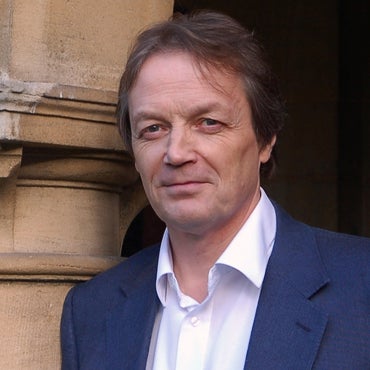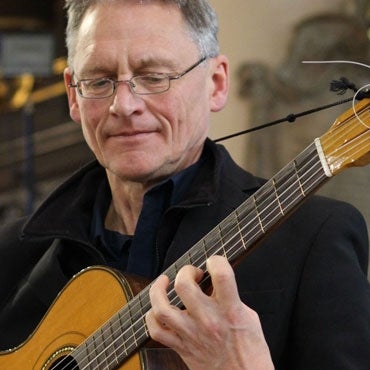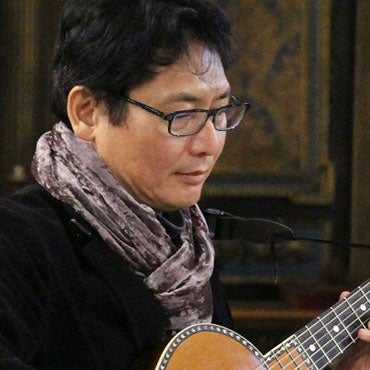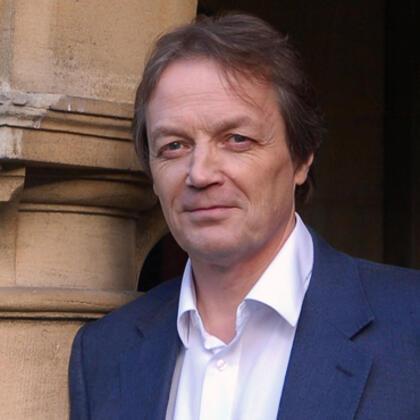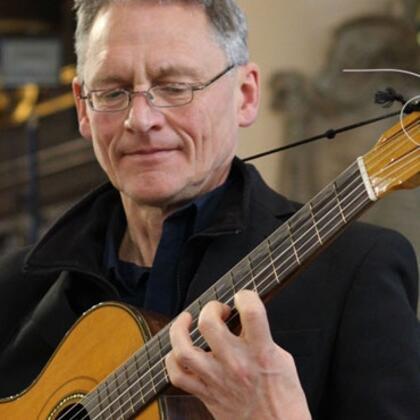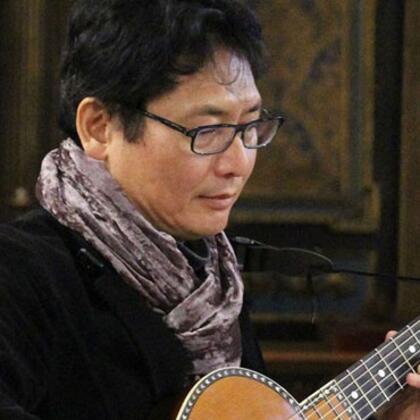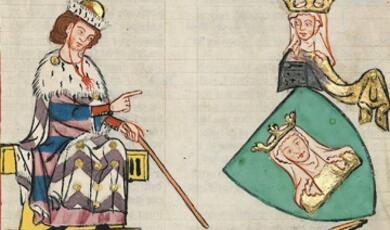The Guitar and the Romantic Vision of the Medieval World
Share
- Details
- Transcript
- Audio
- Downloads
- Extra Reading
Between approximately 1750 and 1850, interest in the Middle Ages was fed by many activities with porous boundaries, including the antiquarianism of those who collected coins, seals and armour and the collection of poems generally called ‘ballads’ regarded as the core materials of nascent national literatures.
In poetry, and the many new publications offering serialised fiction in the Regency period, the guitar was often associated with a vanished medieval past, imagined as a time of Catholic ignorance but also of political stability and fluent minstrelsy. Here, as in other respects, the associations of the guitar ran counter to nineteenth-century industrialism and the encroachment of new brick-built suburbs into green land, and even to Anglicanism, since the guitar was strongly associated with Catholic Spain and an imagery of warm nights, vesper bells, and elderly duennas nodding over their books of hours.
Download Transcript
08 January 2015
The Guitar and the Romantic Vision of the Medieval World
Professor Christopher Page
I began with a stanza from The Eve of St Agnes, the great romance in verse composed by John Keats in 1819. He is describing a very medieval room:
A casement high and triple-arch’d there was,
All garlanded with carven imag’ries
Of fruits, and flowers, and bunches of knot-grass,
And diamonded with panes of quaint device,
Innumerable of stains and splendid dyes,
As are the tiger-moth’s deep-damask’d wings
And in the midst, ’mong thousand heraldries,
And twilight saints, and dim emblazonings,
A shielded scutcheon blush’d with blood of queens and kings.
It has long been known that Keats was inspired to write this passage, and much else in this poem, by some medieval architecture that he had recently seen near Chichester. Although this is one of the great medieval poems of the romantic period, Keats uses neither the word ‘medieval’ nor the term ‘Middle Ages’. Nonetheless, thenotion of a middle time, intervening between the ancient world and a recognizable modernity, was very well established in his day, and was partly the bequest of the churchmen, theologians and controversialists in the eighteenth century. Such men could scarcely survey the history of the Church, or of its doctrines, without recognizing that something had come to an end, at least in Britain, with the Reformation that extinguished the universal Latin Church and made Canon Law, as used hitherto, redundant. Look for the term ‘Middle Ages’ in works before about 1750, for example, and you are likely to find yourself reading books with titles like The rule and exercises of holy livingor The clergy-Man’s vade mecum.
No matter how the medieval period was understood in chronological terms (and estimates varied in he time of John Keats, as they still do) it was the site of a richly polemical debate (as it still is). Many were both attracted and troubled by the memory of a Catholic Britain, rude in its manners and prey to superstition, but sustained by the work of dignified artisans in shops, not by workers in factories where machines left ‘the pale spinner, prematurely bowed’. Then there was the great enigma of the gothic cathedrals, vast structures of stone that we by far the most spectacular buildings in many cities but were nonetheless ‘reared upon superstition’, meaning Catholic Christianity, as a correspondent wrote in The Ladies’ Monthly Museum for December 1, 1821. For all their licentiousness and violence, it also seemed that medieval men and women had known how to value a hero, deal with en errant king or arrange an opulent ceremony, for theirs was not a ‘staid and reasonable time’ such as the sonneteer John Hanmer discerned his own to be in 1840 under Victoria.
I would like you now to consider an engraving that I have shown you before, but which now deserves a closer look. You have it on the first page of your handout. Dating from 1832, and published in London, it is based on a painting by C. Tomkins, whom I take to be the artist Charles Tomkins, who died in 1823, but I have not been able to locate the original picture, if indeed it still exists. Entitled ‘The Minstrel’, it shows a scene that was obviously posed in a studio (there are not usually curtains hanging across the trees in a forest, such as you can see on the right). A guitarist plays in a woodland glade to three women who have been gathering flowers. Their castle can be seen on a hill in the background, and one of the women wears a pendant cross to confirm, together with the costumes, that this is a scene of aristocratic life in the Catholic Middle Ages.
How did an instrument from the time of the young Charles Dickens, one that we associate with jaunts, picnics, steamships and London music shops, come to be shown in the hands of a medieval minstrel? Would the artist have done better, given the nature of the scene, to draw a lute? These questions raise the broader issue of when the concept of a historical anachronism arose. During much of the period that concerns us this afternoon it is nascent, although some would argue (with C. S. Lewis) that it took a great leap forward with the Waverley novels of Sir Walter Scott. Perhaps, in our particular case, there is a very simple explanation for the presence of a guitar in the engraving before us. In 1777, a musician named John Marsh searched the London music shops trying to find a lute because one of his friends had expressed a wish to play one. Marsh looked high and low for what he calls this ‘exploded’ instrument, and finally managed to locate a certain Mr Straube, a German, ‘in a garrett at Pimlico’ who had a lute and was able to play it. This was a sorry fate for the instrument that had once inspired Shakespeare to remark how strange it is that ‘sheeps’ guts should hale souls out of men’s bodies’, but there it is. By the time John Marsh began his search, the lute had been virtually unknown for many years.
So there is a one very simple answer to the question I posed a moment ago. The artist who produced our engraving shows a guitar in a medieval woodland scene because he had never seen a lute and eh thought a guitar was the next best thing. Perhaps he even thought that a lute might have looked like something like this (such confusion is still very common today, notably amongst those who catalogue prints and paintings, for example, as I know to my cost). But as you will have guessed, there is a more searching answer to the question of how the guitar came to be shown in a medieval context in our print, or rather a range of answers, which I would like to explore this afternoon.
The disappearance of the lute did not prevent poets in the Romantic period from mentioning it in verse, and they did so freely, from Keats, Wordsworth, Byron and Coleridge down to the humblest versifier of the poetry, often derided, published in the columns of the newspapers. Indeed, the word ‘lute’ was evocative precisely because it was used by the great poets of the past – notably William Shakespeare and John Milton – but no longer meant anything precise in terms of wood, strings or the banality of lessons to be paid for by the hour Once more The Eve of St. Agnes seems the obvious place to look:
Awakening up, he took her hollow lute,—
Tumultuous,—and, in chords that tenderest be,
He play’d an ancient ditty, long since mute,
In Provence call’d, “La belle dame sans mercy:”
Close to her ear touching the melody;—
The fading of the lute as an object, but the force of its evocative name, allowed one enterprising musician of London to reinvent the lute and then to market the results under that name. In my last lecture I introduced you to Edward Light, who died in 1832, and to the various hybrid instruments that he invented, including the harp-lute, which he sometimes advertised simply as the lute, and the harp-guitar. Edward Light’s remarkable labours explain how the governess Nelly Weeton in 1809 could ponder buying a ‘lute’ she had seen in a Liverpool music shop, and how one of the most popular singers of our period, Kitty Stevens, cam to be shown with a harp-lute in a portrait by George Henry Harlow.
You have this portrait on the second page of the handout. Notice the costume and setting. She wears something like a Tudor ruff around her neck, and a gown and hat of the opulent red velvet so often associated in our period with liturgical vestments of the Middle Ages and rich court dress. Notice also the surrounding masonry arch which is already half ruinous as the vegetation encroaches on what we are perhaps to suppose is an ancient deserted building. We heard one of these very rare instruments in my last lecture, and by popular demand (for I have received many message about it) Taro Takeuchi has come back today to play for us again.
Taro Takeuchi, Le Plaisir des Dames, from Edward Light’s method for the harp lute.
When Keats puts a ‘lute’ into The Eve of St. Agnes, he was doing more than exploiting an evocative and archaic word as he had used ‘emblazonings’ and ‘scutcheon’. He was drawing upon a potent association between the Middle Ages, as imagined in his day, and ancient song, both lyric and narrative, to the accompaniment of a stringed instrument. Keats was born in 1795; during the two generations before him, antiquarians, scholars and readers of many callings gradually realized that it was possible to expand the bounds of their curiosity, and especially their literary curiosity, beyond the constraints of the urbane, the polite and the learned – beyond classicism, if you will. As a result of disorganized but devoted antiquarian pursuits, many of them conducted in gentlemen’s studies and in country rectories, not at all in universities, vast reaches of archaic European story and verse slowly came into view during the 1700s, like a landscape as floodwaters drain away, challenging the very notion of literature as commonly understood, and of authorship. For the British, the material discovered included Scottish and northern-English balladry, the relics of the Welsh bards, Irish poetry both genuine and fake, medieval romance and Middle English lyric. More broadly it included, for example, the slow but sure recognition accorded in Britain to the Provençal troubadours, of whom Keats had evidently heard a little (remember the song ‘In Provence call’d, “La belle dame sans mercy’) but evidently did not know much.
It was widely assumed, and to some extent with good reason, that much of the English and Celtic heritage had originally circulated as forms of song accompanied by the string-music of bards, minstrels and troubadours, between whom (in many cases) no very sharp distinction was drawn. To Sir John Hawkins, who published his groundbreaking General History of Music in 1776, these entertainers were quite simply ‘the fathers of modern poetry and popular music’. How did musicians imagine the music of those remote figures? Most made very little distinction between what we would now call medieval and renaissance music for want of any published material on which to based it, and adhered to a very general notion of something melodic, harmonically straightforward and dance-like: what I would call the Greensleeves view of pre-modern music (which is not altogether dead). You can hear all those qualities in the piece that Uli is going to play for us on a guitar made about 1830. By Napoleon Coste, who was born in 1805, it is entitled La Romanesca, a name designed to allude to a ground of the sixteenth century.
Ulrich Wedermeier: Napoleon Coste, La Romanesca. Op. 19b
As more and more genuinely medieval literature was put into print by antiquaries with a humane interest in both the poetry itself and in what they called the ‘manners and customs’ of the past, the importance of song and stringed instruments in that reconstruction of literary and national history only became the more apparent. To learned men who knew their Homer, theee was nothing surprising about this; the lute of the medieval minstrel, or the harp of the Welsh bard, simply replaced the lyre of the Homeric rhapsode. In 1802, for example, Joseph Ritson published an influential volume entitled Ancient English Metrical Romanceës, making a number of Middle English narratives of love and chivalry available. This book did much to establish a pervasive sense that the medieval world, like Prospero’s island, had a thousand twangling instruments:
Then of course there was Geoffrey Chaucer. Even those who read no further than the General Prologue to the Canterbury Tales met a wide range the harp, rote, fiddle, psaltery and gittern, to say nothing (and I would rather not) of the miller’s bagpipes. The Knight’s Tale brings the citole. By 1810, interest in medieval instruments had reached the point where antiquarians like Francis Douce, who died in 1834, were searching through illuminated manuscripts, and scanning carvings, for representations of medieval musical instruments, then carefully sketching them in their notebooks. You have one as the third item on your handout. All this is eloquently summed in the title page of Percy’s Reliques of Ancient English Poetry, which I give you, as the fourth item on your handout, originally published in 1765, but here from the second edition of 1839. (The engraved image is identical in both editions).
You will notice Percy’s title page shows a harp. We still do not have an answer to my opening question of how the guitar found its way into anyone’s conception of the Middle Ages, as it does in the engraving with which we began? Part of the answer can be traced to contemporary British perceptions of Spain, a country regarded as the ultimate home of the guitar. Here is part of piece that appeared in the The Morning Chronicle for August 18, 1823:
‘the aspect of the country, [Spain] and the manners of its inhabitants, might for a time create an illusion in the mind of an imaginative traveller. He might fancy himself transported back through some distance and obscurity of time, to a scene laid in the middle Ages. A country thinly interspersed with villages, the neglected state of agriculture; the rude and clumsy construction of their vehicles and implements; the prospect of a fertile and extensive territory producing a bare subsistence for a scanty population’.
As I have had cause to remark in these lectures before, the Peninsular War of 1808-1814 did much to inspire an interest in Spain and the Spanish people, eventually presented in many newspapers and poems as fellow travellers with the British in their determination to preserve their liberty, at all costs, from Napoleon. Even the most Hispanophile English writers who visited Spain, however, such as Richard Ford, tended to evoke a primitive country that scarcely merited its place on the board of European states. According to the guidebooks that Ford published in the 1840s, Spain had virtually no effective force of law and order; the banditry described, indeed celebrated, in picaresque fiction like Gil Blas, was rife in the cities and yet worse in the countryside. Her public officials were corrupt and indolent; only a superstitious and oppressive Church showed signs of vigour.
Just as Spain was widely supposed to be a quasi-medieval country, the memory of its medieval past was believed to be apparent to Spaniards in a manner unparalleled elsewhere, only explicable in terms of the Muslim presence in Iberia, for many centuries of the Middle ages, such as no other European country had known. In 1807, Lady Morgan Sydney Owenson published a poem entitled ‘The Spanish Guitar’, recounting her discovery of an instrument with the label Lorenzo Alonso, Madrid, 1784, in a ‘small town in the north of Ireland’. (Alonso is a well-known maker, incidentally). She associates it with the celebration, in song, ‘Of vanquish'd Moor, of Saracen subdued…’.Or we have Lord Byron in his poem The Girl of Cadiz:
And when, beneath the evening star,
She mingles in the gay Bolero,
Or sings to her attuned guitar
Of Christian knight or Moorish hero,
Or counts her beads with fairy hand
Beneath the twinkling rays of Hesper,
Or joins Devotion's choral band,
To chaunt the sweet and hallowed vesper;
It was a short step from having Spaniards in poetry and fiction sing of the medieval past to actually writing historical fiction in which the national instrument of Spain, the guitar, is transported back in time to the Middle Ages as a transhistorical, almost an eternal, property of medieval Spain. We open The Spanish Lady and the Norman knight: A Romance of the Eleventh century by Kate Montalbion, published in 1810, and find a heroine who find herself ‘in a delightful boudoir, furnished with vases of the purest water… Two stools of the most exquisite beauty formed as triangles, filled the recesses; on one was a guitar, on the other a spaniel…’. Let me remind you that is a description of an eleventh-century room. In 1825, London theatregoers could see a play, Alphonzus, set in the final years of Visigothic Spain. According to the play, that was a time a woman might
….string the soft guitar, and from its chords
Her rosy fingers waft such rapturous sounds
As nought on earth could equal…’.
So here is the guitar in seventh-century Iberia on the nineteenth-century English stage.
Such imagery spread wide with the poetry, history and fiction that was increasingly available in serialised magazines such as Le Belle assemblée or could be borrowed from the subscription libraries. A guitarist in the early nineteenth century was almost invariably a reader, and was most often a woman. The next item on the handout shows a print of the 1820s, entitled by hand A girl at her studies. The title is ironical, of course, and the work is essentially misogynistic, or at least condescending; the ‘girl’ has paused to read a letter, perhaps a love letter. She has also been literally cornered. Yet she has her books, her porftolios for her sketches, her globe for the study of geography, her harp and her guitar.
Descriptions of medieval life began to proliferate with the continuing rise of the boarding schools for women, the growth of the governess class and the many textbooks published for use in those contexts. Mrs Markham’sHistory of England, for example, first published in 1823 and a schoolbook widely used, evokes the great hall at Penshurst Place in Kent where ‘the nobles and their guests sat at table…entertained by singers, minstrels and dancers’. That is the kind of image that many a governess was teaching her charges to remember, sometimes it seems with lasting effect. The novel Village Belles by Anne Manning, published in 1833, has a heroine whose ‘drawings were bold, sketchy, and incorrect. She would often cover a sheet of paper with odd groups of knights errant, ladies, pages, squires, and long robed signors, which reminded one of Cervantes, or Ariosto, or Spenser’s Fairy Queen…’ Notice how the truly medieval (‘knights errant’) is mingled here with renaissance literature (Ariosto) and even early baroque parody of medieval literature (Cervantes).
What might such a young woman have read for pleasure? Perhaps a story like ‘The Guelf and the Ghibelline: A romance of the Middle Ages’, serialized in La Belle Assembléeduring 1824; in that story, the ‘fond guitar’ of the hero is as regular as ‘the convent Vesper hymn’ beneath the window of the heroine. Or perhaps a poem entitled The Artist’s chamber: a Sketch on the Spot, from 1820 by the minor romantic poet George Croly:
The room was low and lone, but linger’d there,
In careless loveliness, the marks of mind;
The page of chivalry, superb and drear,
Beside a half-filled vase of wine reclined,
Told how romance and gaiety combined…
And there lay a guitar, whose silvery string
Breathed to the wind…
Or it might be this, published with one or the many albums of the period, The Literary Souvenir, in 1827:
We should also reckon here with a resurgence of interest in the troubadours, the songwriters who are first traceable around 1100 in the large territory of central and southern France which once had its own form of romance tongue, now commonly called Occitan. (It is quite different to French, though a closely related child of Latin). The notion of the troubadour as a poet whose verse was usually wedded to music, who sought patrons but was essentially a free spirit, not contaminated by political intrigue or commercial constraints, and wandering where his fancy took him, proved deeply congenial to many in the romantic England. What is more, the troubadours provided a way for many generations of writers and readers to explain how how European vernacular poetry, song and drama had ever managed to arise in what Thomas Warton in 1774 called ‘an age of the grossest ignorance and cruelty’. For the most part, those conceptions were free to expand without any limitations imposed by historical fact.The periodical La Belle Assemblée published a potted history of music in April 1818 with a brief section on the troubadour which places them in the ninth century, which is wildly incorrect, and then (in a manner that some might regard as characteristically English) interprets their decline around 1300 in moral terms: ‘They eventually degraded themselves to such a degree that they ‘gained a reputation for impudent effrontery’.
Some male amateur guitarists in England, it seems, thought of themselves as parlour troubadours: a remarkable form of practical medievalism. We know this, as we know many things about the romantic guitar, through the work of satirists. In December 1830, the Hull Packet and Humber Mercury reported that the guitar was much in favour ‘with gentlemen of lank, attenuated fingers who have pretensions to a romantic bearing’. However, this observation comes with a warning. ‘[T]he guitar is the instrument to make a sensation in the drawing room but we do not recommend it to men weighing more than fifteen stone from the difficulty of assuming an appropriate troubadour air’.
We smile at that, but it is the task of satire to identify a genuine target, and I think that example does. ‘An appropriate troubadour air.’ Is that what you see in the last image on the handout? The young man shown in this cartoon of 1829 is reading a number of the Literary Gazette. It is impossible to say which number, but I can at least report that the issues for 1829 are decidedly troubadouresque. On p. 92-3, our guitarist man would have found the review of a recent concert by a French group of entertainers called Les Trois Troubadours, mentioned above, which specially commends the part of their repertoire most touched by medievalism. “The chief treat is in the chansons a la Troubadour’, runs the review, ‘which are given with great sweetness, elegance, and finish, by the principal songster’. Further on, he wouldhave met a review of new paintings exhibited at the Royal Academy, including one entitled A Troubadour relating his Adventures to a party of Ladies. ‘The spirit of love and Romance pervades this elegant and well-painted group, and carries the imagination back to the days and regions of chivalrous gallantry and exploit’. Later pages brought the review of a songbook, revealingly entitled Songs of the Minstrels by Joseph Barnet.
Ulrich Wedermeier and Taro Takeuchi, Le chevalier errant (anon)
© Professor Christopher Page, 2015
This event was on Thu, 08 Jan 2015
Support Gresham
Gresham College has offered an outstanding education to the public free of charge for over 400 years. Today, Gresham plays an important role in fostering a love of learning and a greater understanding of ourselves and the world around us. Your donation will help to widen our reach and to broaden our audience, allowing more people to benefit from a high-quality education from some of the brightest minds.


 Login
Login
